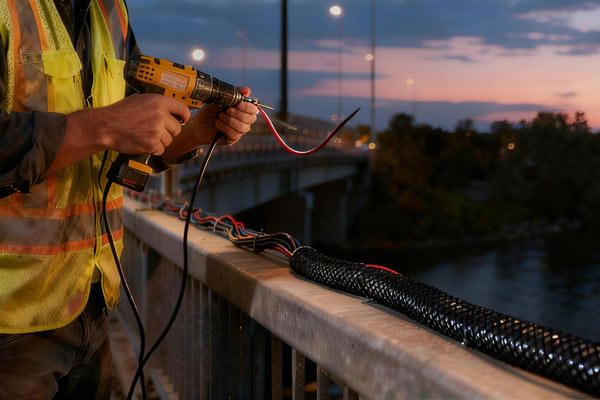Categorie
Ultimo blog
In Australia o in Medio Oriente, la radiazione ultravioletta (UV) è particolarmente intensa: l'esposizione prolungata al sole all'aperto può facilmente causare l'invecchiamento, la rottura o addirittura la rottura delle guaine dei cavi. Negli impianti di illuminazione esterna, la guaina dei cavi, spesso trascurata, è in realtà molto importante.

Si potrebbe pensare: "La guaina è solo qualcosa che si avvolge attorno al cablaggio e basta", ma in realtà, soprattutto nelle installazioni di illuminazione esterna, la scelta della guaina è molto Critico. Se la guaina non è resistente ai raggi UV, il cavo ingiallirà molto rapidamente, diventerà fragile o si screpolerà. Se il cavo rimane esposto per lunghi periodi e la guaina non è sufficientemente robusta, acqua, polvere o sabbia trasportata dal vento danneggeranno il cablaggio. La guaina non serve solo a proteggere il cavo: è fondamentale per garantire che l'impianto di illuminazione sia sicuro, esteticamente gradevole e facile da installare.
Molti clienti o progettisti preferiscono scegliere la guaina bianca perché ha un bell'aspetto, ma devono anche trovare il giusto equilibrio tra stabilità a lungo termine e protezione dai raggi UV per garantire che l'impianto di illuminazione sia sicuro e durevole.
La scelta di un materiale PET resistente ai raggi UV consente un utilizzo esterno a lungo termine, mantenendo un'elevata resistenza agli agenti atmosferici, prevenendo ingiallimento, fragilità o screpolature, prolungando così la durata dell'impianto di illuminazione. La guaina può proteggere saldamente i cavi, mantenendo un aspetto ordinato e integrandosi perfettamente con gli apparecchi di illuminazione o i colori dell'ambiente. La guaina bianca ha anche proprietà riflettenti, che possono migliorare l'effetto di dispersione della luce, rendendo luci e ombre più morbide e stratificate. Il materiale PET è leggero, ha un'eccellente resistenza all'abrasione e flessibilità, può adattarsi a cablaggi curvi e strutture di installazione complesse e allo stesso tempo protegge il cavo interno dall'abrasione meccanica.
Guaina di protezione dei cavi non riguarda solo la sicurezza, ma anche l'effetto visivo del progetto e l'efficienza dell'installazione.
Tuttavia, la guaina bianca è più difficile da realizzare rispetto a quella nera. Il colore naturale della guaina in PET è solitamente nero o una tonalità chiara trasparente. Nell'industria, la maggior parte delle guaine in PET standard, per ottenere la migliore resistenza ai raggi UV, al calore e alla fiamma, viene prodotta con l'aggiunta di un pigmento nero di carbonio, che offre una protezione UV naturale e una maggiore durata.
La guaina bianca ha un aspetto più gradevole, ma è necessario aggiungere un pigmento o un riempitivo bianco: questi pigmenti sono generalmente biossido di titanio o coloranti simili, utilizzati per conferire alla guaina un aspetto esterno bianco. Dopo l'aggiunta del pigmento, il materiale potrebbe influire su alcuni indicatori di prestazione, ad esempio:
Resistenza all'abrasione: la resistenza delle fibre potrebbe essere leggermente inferiore rispetto alla versione nera
Resistenza alla fiamma: alcuni pigmenti possono ridurre le valutazioni di resistenza alle alte temperature o alla combustione
Resistenza agli agenti atmosferici UV: è necessario aggiungere uno stabilizzatore UV extra, altrimenti l'uso esterno a lungo termine porterà a ingiallimento o fragilità
Il prezzo è solitamente leggermente più alto, perché sono necessari ulteriori trattamenti di pigmento e ottimizzazione del materiale per garantire che la guaina bianca possa essere utilizzata a lungo termine all'esterno. In breve: chi punta sull'aspetto estetico, deve pagare un prezzo, e bisogna essere consapevoli che le prestazioni potrebbero essere leggermente inferiori rispetto alla guaina nera.